Related Research Articles

William III, also widely known as William of Orange, was the sovereign Prince of Orange from birth, Stadtholder of Holland, Zeeland, Utrecht, Guelders, and Overijssel in the Dutch Republic from the 1670s, and King of England, Ireland, and Scotland from 1689 until his death in 1702. As King of Scotland, he is known as William II. He ruled Britain and Ireland alongside his wife, Queen Mary II, and their joint reign is known as that of William and Mary.

The House of Orange-Nassau is the current reigning house of the Netherlands. A branch of the European House of Nassau, the house has played a central role in the politics and government of the Netherlands and elsewhere in Europe, particularly since William the Silent organised the Dutch Revolt against Spanish rule, which after the Eighty Years' War (1568–1648) led to an independent Dutch state. William III of Orange led the resistance of the Netherlands and Europe to Louis XIV of France, and orchestrated the Glorious Revolution in England that established parliamentary rule. Similarly, Queen Wilhelmina of the Netherlands was instrumental in the Dutch resistance during World War II.

Sir Constantijn Huygens, Lord of Zuilichem, was a Dutch Golden Age poet and composer. He was also secretary to two Princes of Orange: Frederick Henry and William II, and the father of the scientist Christiaan Huygens.

William II was sovereign Prince of Orange and Stadtholder of Holland, Zeeland, Utrecht, Guelders, Overijssel and Groningen in the United Provinces of the Netherlands from 14 March 1647 until his death three years later. His only child, William III, reigned as King of England, Ireland, and Scotland.
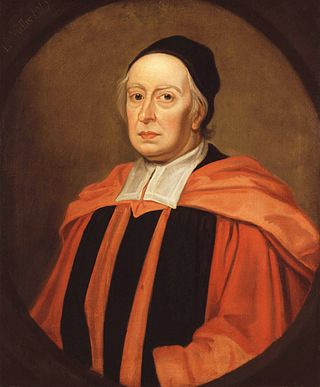
John Wallis was an English clergyman and mathematician, who is given partial credit for the development of infinitesimal calculus.

Amalia of Solms-Braunfels was Princess of Orange by marriage to Frederick Henry, Prince of Orange. She acted as the political adviser of her spouse during his reign, and acted as his de facto deputy and regent during his infirmity from 1640 to 1647. She also served as chair of the regency council during the minority of her grandson William III, Prince of Orange from 1650 until 1672.
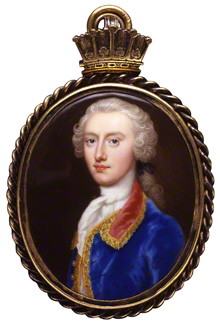
William Henry Nassau de Zuylestein, 4th Earl of Rochford, KG, PC was a British courtier, diplomat and statesman of Anglo-Dutch descent. He occupied senior ambassadorial posts at Madrid and Paris, and served as Secretary of State in both the Northern and Southern Departments. He is credited with the earliest-known introduction of the Lombardy poplar to England in 1754.

Mary, Princess Royal, was an English princess, a member of the House of Stuart, and by marriage Princess of Orange and Countess of Nassau. She acted as regent for her minor son from 1651 to 1660. She was the first holder of the title Princess Royal.
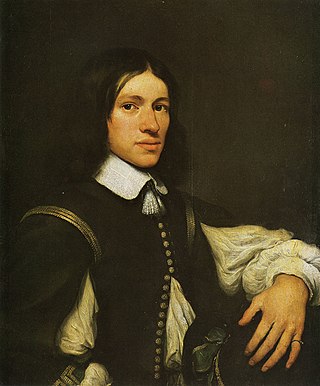
Anthonie Heinsius was a Dutch statesman who served as Grand Pensionary of Holland from 1689 to his death in 1720. Heinsius was a tough negotiator and one of the greatest and most obstinate opponents of the expansionist policies of Louis XIV's France. He was one of the driving forces behind the anti-France coalitions of the Nine Years' War (1688–97) and the War of the Spanish Succession (1701–14).
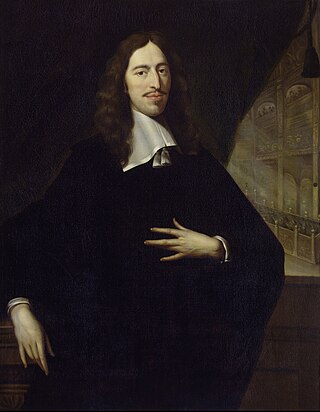
A pensionary was a name given to the leading functionary and legal adviser of the principal town corporations in the Low Countries because they received a salary or pension.
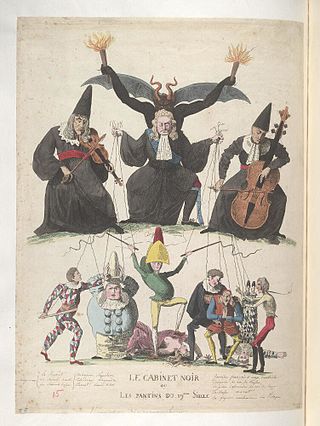
In France, the cabinet noir was a government intelligence-gathering office, usually within a postal service, where correspondence between persons or entities was opened and read by government officials before being forwarded to its destination. However, this had to be done with some sophistication, as it was considered undesirable if the subjects of the practice knew about it, and important "that the black chamber not interrupt the smooth running of the postal service." This practice had been in vogue since the establishment of postal and telegraphy services, and was frequently used by the ministers of Louis XIII and Louis XIV; but it was not until the reign of Louis XV that a separate office for this purpose was created. This was called the cabinet du secret des postes, or more popularly the cabinet noir. Although declaimed against at the time of the French Revolution, it was used both by the revolutionary leaders and by Napoleon.
Thomas Phelippes (1556–1625), also known as Thomas Phillips was a linguist, who was employed as a forger and intelligence gatherer. He served mainly under Sir Francis Walsingham, in the time of Elizabeth I, and most notably deciphered the coded letters of Babington Plot conspirators.

The Order of the Gold Lion of the House of Nassau is a chivalric order shared by the two branches of the House of Nassau.

Henri de Fleury de Coulan, Sieur de Buat, St Sire et La Forest de Gay was a captain of horse in the army of the Dutch Republic, who became embroiled in a celebrated conspiracy during the First Stadtholderless Period to overthrow the regime of Grand Pensionary Johan de Witt in favor of future Stadtholder William III, known as the Buat Conspiracy. He was convicted of treason in 1666 and executed.
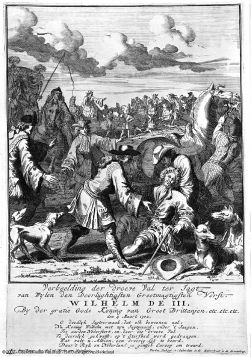
The Second Stadtholderless Period or Era is the designation in Dutch historiography of the period between the death of stadtholder William III on March 19, 1702, and the appointment of William IV as stadtholder and captain general in all provinces of the Dutch Republic on 2 May 1747. During this period the office of stadtholder was left vacant in the provinces of Holland, Zeeland, and Utrecht, though in other provinces that office was filled by members of the House of Nassau-Dietz during various periods. During the period the Republic lost its status as a great power and its primacy in world trade. Though its economy declined considerably, causing deindustralization and deurbanization in the maritime provinces, a rentier-class kept accumulating a large capital fund that formed the basis for the leading position the Republic achieved in the international capital market. A military crisis at the end of the period caused the fall of the States-Party regime and the restoration of the Stadtholderate in all provinces. However, though the new stadtholder acquired near-dictatorial powers, this did not improve the situation.
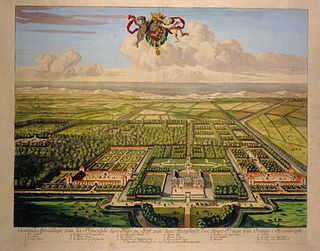
Huis Honselaarsdijk is a former palace and country residence of the Dutch Stadtholders and princes of Orange which lies about 2.6 km southwest of the border of The Hague, the Netherlands. It was one of the finest examples of Baroque architecture in The Netherlands. Today, only part of the outbuildings remain and are known locally as De Nederhof.

Constantijn Huygens Jr., Lord of Zuilichem, was a Dutch statesman and poet, mostly known for his work on scientific instruments. But, he was also a chronicler of his times, revealing the importance of gossip. Additionally, he was an amateur draughtsman of landscapes.

Princess Frederica Louise Wilhelmina of Orange-Nassau was a Hereditary Princess of Brunswick; married 14 October 1790 to Hereditary Prince Charles George August of Brunswick-Wolfenbüttel, son of Charles William Ferdinand, Duke of Brunswick-Wolfenbüttel. She was known in the family as "Loulou".
William Blencowe was a British scholar and cryptographer who was the first official Royal Encipherer appointed by Queen Anne of England. He worked for the English and other Allied governments during the War of the Spanish Succession.
François Jaupain was the Director-general of the postal system in the Southern Netherlands between 1706 and 1725, which position he used to sell information to the Allied side in the War of the Spanish Succession and to act as a spymaster in the service of the Governor-General of the Austrian Netherlands Prince Eugene of Savoy.
References
- ↑ De Leeuw (1999), p. 133
- 1 2 3 Huygens, C. (1899). Oeuvres Complètes de Christiaan Huygens. Vol. 8. M. Nijhoff. p. 421, note 4. Retrieved 4 August 2023.
- 1 2 Thompson, p. 169
- ↑ Hora Siccama, J.H. (1915). "Aanteekeningen en verbeteringen op het register op de journalen van Constantijn Huygens den zoon". Werken Historisch Genootschap, 3e serie (in Dutch). Vol. 35. Amsterdam. p. 13.
{{cite book}}: CS1 maint: location missing publisher (link) - ↑ De Leeuw (1999) pp. 135, 147
- ↑ Glozier, M.; Onnekink, D. (2017). War, Religion and Service: Huguenot Soldiering, 1685–1713. Routledge. p. 194. ISBN 9781351873888 . Retrieved 4 August 2023.
- ↑ De Leeuw (1999), pp. 147-148
- 1 2 De Leeuw (1999), p. 148
- ↑ De Leeuw (1999), pp. 148-149
- ↑ De Leeuw (2000), p. 22
- ↑ De Leeuw (1999), pp. 150-151
- ↑ De Leeuw (1999), pp. 135, 147
- ↑ De Leeuw (1999, p. 142
- ↑ De Leeuw (1999), P. 156
- ↑ De Leeuw (2000), p. 23
- ↑ De Leeuw (2000), pp. 23-24